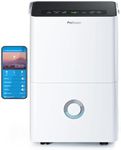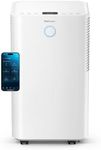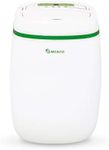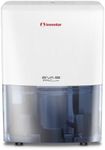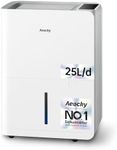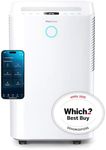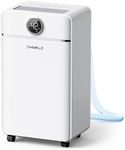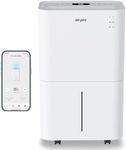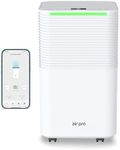Buying Guide for the Best Wifi Dehumidifier
Choosing the right WiFi dehumidifier can significantly improve the air quality in your home by reducing excess moisture and preventing mold growth. When selecting a WiFi dehumidifier, it's important to consider several key specifications to ensure it meets your needs. Understanding these specs will help you make an informed decision and find the best fit for your space and lifestyle.Dehumidification CapacityDehumidification capacity refers to the amount of moisture a dehumidifier can remove from the air in a 24-hour period, usually measured in pints or liters. This spec is crucial because it determines how effective the dehumidifier will be in your space. For small rooms or areas with mild humidity, a lower capacity (20-30 pints) may suffice. For larger spaces or areas with high humidity, you may need a higher capacity (50-70 pints). Assess the size of the area and the level of humidity to choose the right capacity for your needs.
Coverage AreaCoverage area indicates the maximum square footage that the dehumidifier can effectively handle. This is important to ensure that the device can manage the moisture levels in the entire space you intend to use it in. Small dehumidifiers typically cover up to 300 square feet, medium ones cover 300-700 square feet, and large units can cover over 1,000 square feet. Measure the area where you plan to use the dehumidifier and select a model that can cover at least that much space.
WiFi ConnectivityWiFi connectivity allows you to control and monitor your dehumidifier remotely using a smartphone app. This feature is important for convenience and ease of use, especially if you want to adjust settings or check the status of the dehumidifier while you are away from home. Look for models that offer a user-friendly app with features like humidity level monitoring, scheduling, and alerts. If you value smart home integration and remote control, prioritize models with robust WiFi capabilities.
Energy EfficiencyEnergy efficiency refers to how much electricity the dehumidifier uses to remove moisture from the air. This is important for keeping your energy bills low and reducing your environmental impact. Energy-efficient models often have an Energy Star rating, which means they meet specific energy-saving criteria. If you plan to run the dehumidifier frequently or for long periods, choosing an energy-efficient model can save you money in the long run.
Noise LevelNoise level indicates how loud the dehumidifier is when operating, usually measured in decibels (dB). This is important if you plan to use the dehumidifier in a living space, bedroom, or office where noise could be disruptive. Dehumidifiers typically range from 30 dB (quiet) to 60 dB (louder). If you are sensitive to noise or will use the dehumidifier in a quiet environment, look for models with lower noise levels.
Tank Capacity and Drainage OptionsTank capacity refers to the size of the water collection tank, which determines how often you need to empty it. This is important for convenience and maintenance. Smaller tanks (1-2 liters) need to be emptied more frequently, while larger tanks (4-6 liters) require less frequent emptying. Some models also offer continuous drainage options, allowing you to connect a hose for automatic water removal. If you prefer less frequent maintenance, consider a model with a larger tank or continuous drainage.
Additional FeaturesAdditional features can enhance the functionality and convenience of your dehumidifier. These may include a built-in hygrometer to measure humidity levels, auto-restart after power outages, timer settings, and air filters to improve air quality. Consider which features are important to you based on your specific needs and preferences. For example, if you want to maintain a specific humidity level, a built-in hygrometer and auto-restart feature can be very useful.

